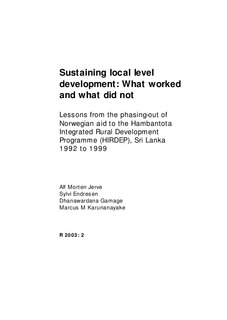| dc.description.abstract | Aid has been successful when it is no longer needed, but we all too often see how aid breeds dependency, and how both donors and recipients have difficulties preparing for termination of the relationship. This is a study of a case of planned phasing-out. Commissioned by the Norwegian Agency for Development Cooperation (NORAD) and the Ministry of Southern Area Development, Government of Sri Lanka, it summarises the main experiences and lessons from twenty years of cooperation in the Hambantota District with a focus on the last phase from 1992 to 1999.
The study looks at two broad themes. Firstly, how were the achievements of HIRDEP in building a more responsive public sector sustained within a changing government structure? And secondly, how did HIRDEP contribute to the new policies of the 1990s of strengthening economic growth, and, in particular, promote institutions able to create economic opportunities for the poor?
The phasing-out did not go as initially planned. The scalingdown of HIRDEP’s expenditure was not gradual. It first peaked and then nose-dived, which indicate that the HIRDEP-organisation tried to sustain a high level of activity as long as possible. Moreover, NORAD changed the policy course mid-way as new political concerns were brought into the picture – especially private sector development.
With the faltering local government reform, it turned out that the new divisions were not capable of replicating and sustaining the development approaches pioneered by HIRDEP. In general, capacity building in public institutions could only be sustained where other financial resources filled some of the vacuum after the withdrawal of HIRDEP.
Probably the most lasting impact of HIRDEP will be its efforts in institution building at the grassroots, related to microcredit and the management of local infrastructure – irrigation, drinking water supply, community centres etc. HIRDEP’s attempt to establish new small-scale industries, by-and-large, failed, while its role as a midwife to the birth of Hambantota District Chamber of Commerce is a remarkable success.
Twenty years of HIRDEP has demonstrated the virtues of having a development catalyst at sub-national level, and the authors make a strong plea for making use of this experience when, at this juncture, government and donors are preparing for reconstruction and development in the war-torn parts of the island. | |
